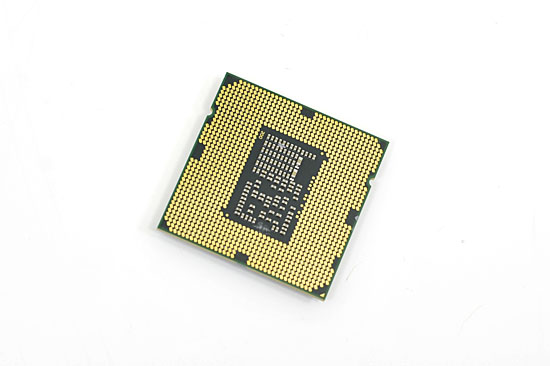The Clarkdale Review: Intel's Core i5 661, i3 540 & i3 530
by Anand Lal Shimpi on January 4, 2010 12:00 AM EST- Posted in
- CPUs
Memory Performance - Not Very Nehalem
Let’s start at the obvious place, memory performance. Nehalem moved the memory controller on-die, but Clarkdale pushes it off again and over to an on-package 45nm graphics core.

To make matters worse, the on-package chipset is a derivative of the P45 lineage. It’s optimized for FSB architectures, not the QPI that connects the chipset to Clarkdale. Let’s look at the numbers first:
| Processor | L1 Latency | L2 Latency | L3 Latency |
| Intel Core i7-975 | 4 clocks | 10 clocks | 34 clocks |
| Intel Core i5-750 | 4 clocks | 10 clocks | 34 clocks |
| Intel Core i5-661 | 4 clocks | 10 clocks | 39 clocks |
| AMD Phenom II X4 965 | 3 clocks | 15 clocks | 57 clocks |
| Intel Core 2 Duo E8600 | 3 clocks | 15 clocks |
L1 and L2 cache latency is unchanged. Nehalem uses a 4-cycle L1 and a 10-cycle L2, and that’s exactly what we get with Clarkdale. L3 cache is a bit slower than the Core i7 975, which makes sense because the Core i5 661 has a lower un-core clock (2.40GHz vs. 2.66GHz for the high end Core i7s) Intel says that all Clarkdale Core i5s use the same 2.40GHz uncore clock, while the i3s run it at 2.13GHz and the Clarkdale Pentiums run it at 2.0GHz.
| Processor | Memory Latency | Read Bandwidth | Write Bandwidth | Copy Bandwidth |
| Intel Core i7-975 | 45.5 ns | 14379 MB/s | 15424 MB/s | 16291 MB/s |
| Intel Core i5-750 | 51.5 ns | 15559 MB/s | 12432 MB/s | 15200 MB/s |
| Intel Core i5-661 | 76.4 ns | 9796 MB/s | 7599 MB/s | 9354 MB/s |
| AMD Phenom II X4 965 | 52.3 ns | 8425 MB/s | 6811 MB/s | 10145 MB/s |
| Intel Core 2 Duo E8600 | 68.6 ns | 7975 MB/s | 7062 MB/s | 7291 MB/s |
Here’s where things get disgusting. Memory latency is about 76% higher than on Lynnfield. That’s just abysmal. It’s also reflected in the memory bandwidth scores. While Lynnfield can manage over 15GB/s from its dual-channel memory controller, Clarkdale can’t break 10. Granted this is higher than the Core 2 platforms, but it’s not great.
What we’re looking at is a Nehalem-like CPU architecture coupled with a 45nm P45 chipset on-package. And it doesn’t look very good. If anything was going to hurt Clarkdale’s performance, it’d be memory latency.










93 Comments
View All Comments
marc1000 - Monday, January 4, 2010 - link
Indeed, I want an Atom+ION, but it has not yet come to public availability in Brazil. And Intel is killing ION with the new Atoms, so I believe I won't ever see a Atom+ION board here, because the stores will only launch only the "newer" Atom boards (that is, IF they even launch it...)efficientD - Saturday, January 9, 2010 - link
The other problem with and atom setup is the low cost no L3 cache Athalons. With a decent 785G mainboard, you can get much better performance in only a slightly bigger package for about the same HTPC money. That is the direction I would go if I could build an HTPC right now.IntelUser2000 - Monday, January 4, 2010 - link
The reason for high idle and in some way, high load power is due to the Asus board. Not only that, but the H57 chipset.The Intel H55 mobo will lower power consumption enough to get it below the i5 750 and i7 860.
Kaleid - Monday, January 4, 2010 - link
Would these be chips on would dare to overclock considering the foxconn socket problems that has been reported here @ anandtech?Zool - Monday, January 4, 2010 - link
Its quite confusing now, with 9 desktop and 11 mobile i-xxx cores now. Not a single digit shows core numbers or the gpu on the new 32nm cpus.Actualy its a total mess now for a average user.
marc1000 - Monday, January 4, 2010 - link
I second your opinion!!! Perhaps Intel hired some marketing folks from Nvidia!!! =DHarry Lloyd - Monday, January 4, 2010 - link
So which chip is responsible for HDMI Audio - the CPU, or the H5x chipset?Can we get HDMI audio support with a Lynnfield CPU?
And one other thing - I assume we can use HDMI audio without haeving to use the integrated GPU (for display) when we have a PCI-E card?
DigitalFreak - Monday, January 4, 2010 - link
The GPU on the processor.Alberto - Monday, January 4, 2010 - link
The main problem is the Motherboard, likely an early sample not much optimized. Both Xbit Lab and The Tech Report have found a lower idle system power consumption in the new Intel plataform versus the Lynnfield solution. Maybe This article needs of a fast update :-)Alberto - Monday, January 4, 2010 - link
The italian site www.hwupgrade.it have discovered even better results. Over an Intel DH55TC motherboard this new cpu is IMPRESSIVE at idle.Intel seems right again.